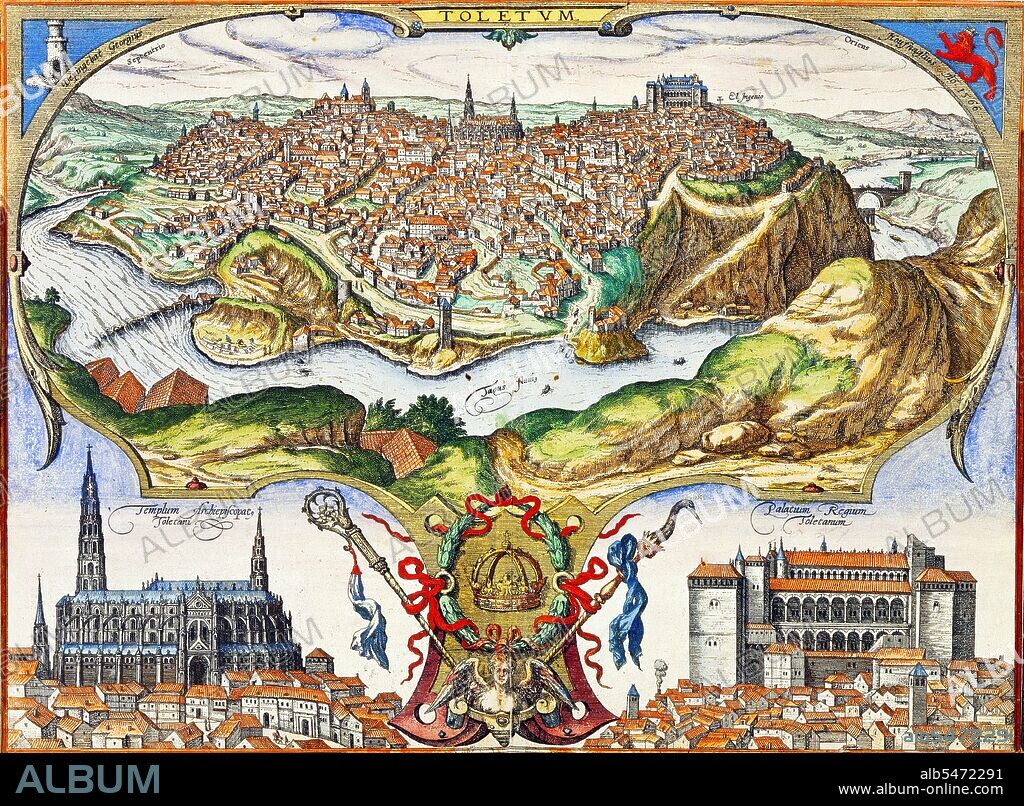alb5472291
Spain-Al-Andalus: View and Plan of Toledo, Braun Hogenberg, Germany, c. 16th century

|
Zu einem anderen Lightbox hinzufügen |
|
Zu einem anderen Lightbox hinzufügen |



Haben Sie bereits ein Konto? Anmelden
Sie haben kein Konto? Registrieren
Dieses Bild kaufen.
Nutzung auswählen:

Titel:
Spain-Al-Andalus: View and Plan of Toledo, Braun Hogenberg, Germany, c. 16th century
Untertitel:
Siehe automatische Übersetzung
Populated since the Bronze Age, Toledo (Toletum in Latin) grew in importance during Roman times, being a main commercial and administrative centre in the Roman province of Tarraconensis. After the fall of the Roman Empire, Toledo served as the capital city of Visigothic Spain, beginning with Liuvigild (Leovigild), and was the capital of Spain until the Muslims conquered Iberia in the 8th century. Under the Caliphate of Cordoba, Toledo enjoyed a golden age; it became a very large cosmopolitan city with an overwhelming Muladi (Iberian Muslim) population. This extensive period is known as La Convivencia, i. e. the co-existence of Jews, Christians, and Muslims. Under Arab rule, Toledo was called Tulaytulah. After the fall of the Caliphate, Toledo was the capital city of one of the richest Taifas of Al-Andalus. Its population was overwhelmingly Muladi, and, because of its central location in the Iberian Peninsula, Toledo took a central position in the struggles between the Muslim and Christian rulers of northern Spain. The conquest of Toledo by Alfonso VI of Castile marked the first time a major city in Al-Andalus had fallen to Christian forces; it served to sharpen the religious aspect of the Christian reconquest.
Bildnachweis:
Album / Pictures From History/Universal Images Group
Freigaben (Releases):
Bildgröße:
4900 x 3601 px | 50.5 MB
Druckgröße:
41.5 x 30.5 cm | 16.3 x 12.0 in (300 dpi)
Schlüsselwörter:
GEMAELDE • GESCHICHTE • ISLAMISCH • KARTE (KARTHOGRAFIE) • KARTE • KARTEN • KARTHOGRAFIE • KARTHOGRAPHIE • KARTOGRAFIE (KARTE) • KARTOGRAPHIE • KUNST • LANDKARTE • MALEREI • MOHAMMEDANER • MOSLEM • MUSLIM • PLAN (KARTOGRAPHIE) • SPANIEN • WISSENSCH.: KARTOGRAPHIE • ZEITGESCHICHTE
 Pinterest
Pinterest Twitter
Twitter Facebook
Facebook Link kopieren
Link kopieren Email
Email
